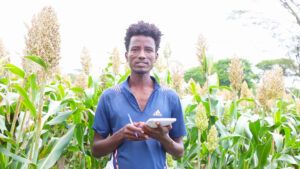 Stories
Stories
September 4, 2023 • 2 min read
Many communities across East Africa have been decimated by the region’s worst drought in over 40 years. Across Ethiopia alone, 24 million people have been affected. In 2022 and 2023, the drought struck Omo Zone, devastating local agro-pastoral communities. Many who relied on their livestock for sustenance and income now found themselves dependent on humanitarian aid.
Livelihoods destroyed by drought
For many communities in Omo Zone, Ethiopia, livelihoods are mainly agro-pastoral. Families rely heavily on local sorghum seeds to generate an income and feed themselves. This seed, however, takes more than five months to yield any produce. When the drought struck, farmlands sown with the local sorghum seed dried up, leaving communities empty-handed. Months of anticipation for a bountiful harvest turned into despair. The situation escalated into a worrisome crisis, with food insecurity gripping the area.
Taking a Chance
In response to this dire situation, a glimmer of hope emerged in the form of a USAID-funded project called RiPA (Resilience in the Pastoral Areas). Collaborating with a reputable seed company, RiPA facilitated access to Climate Adapted, Early Maturing, Moisture Stress-Resistant, and high-yielding sorghum seed to the struggling community at affordable prices.
At first, the introduction of this new sorghum seed variant did not pique the interest of members of the agropastoral community. Scepticism hung heavy in the air, as they were accustomed to their traditional seed. However, one individual named Dembe Muda, a local agropastoral, was willing to take a chance. He purchased the Climate Adapted sorghum seed for 550 Ethiopian Birr and planted it on his land.
Within three months, Dembe’s farmland was teeming with a satisfying sorghum yield. While those who had planted the local seed suffered from limited rainfall and crop failure, Dembe’s perseverance paid off. His farm was brimming with the promise of a successful harvest.
“In our district, there hasn’t been any initiative to introduce a high-yielding seed despite the limited productivity of the local one. Observing the performance of the high-yielding sorghum seed on the farmland, I can say the difference is like day and night. I expect a yield ranging from 12 to 15 quintals per hectare,” Habtamu Yegezu, a government Crop Production Officer for Hamer District, said.

Habtamu Yegezu, a Crop Production Officer for Hamer District, who has been supervising this project’s progress
The risk pays off
Intrigued and inspired by his results, more and more farmers began to visit Dembe’s farmland and ask him to reserve a portion of his yield so that they could plant it on their land during the next farming season.
“As you see, my farm is at the side of the main road, and everyone who passes by the road comes to the farm and asks me to reserve a portion of it. I didn’t know this was possible, yet thanks to this project, I am going to harvest the highest yield since I started farming,” Dembe said proudly.”
You can support GOAL’s work in Ethiopia with a donation today.
